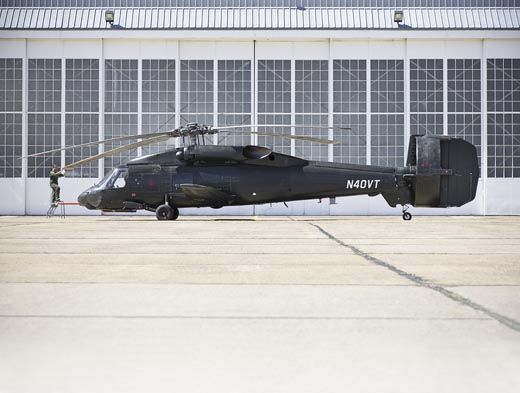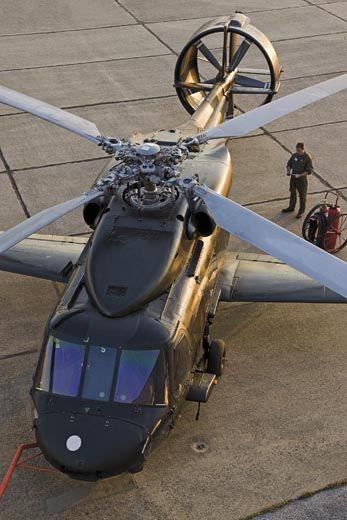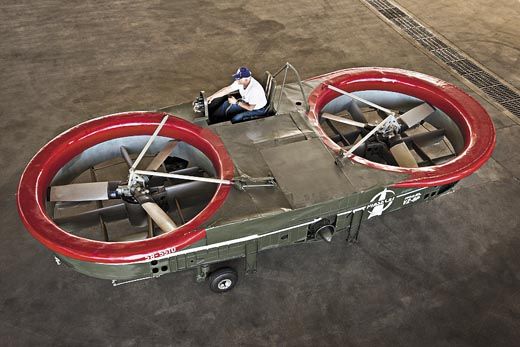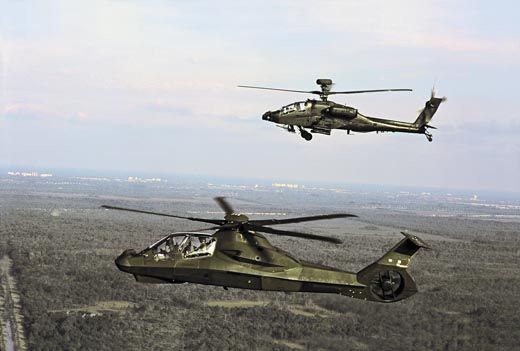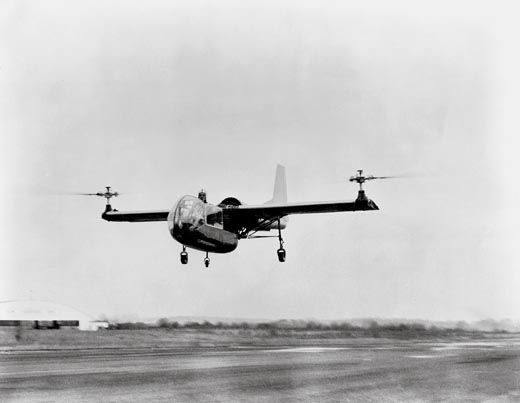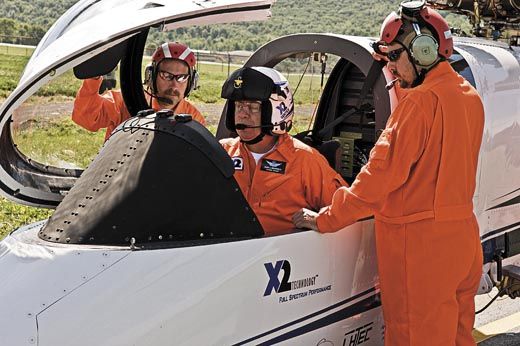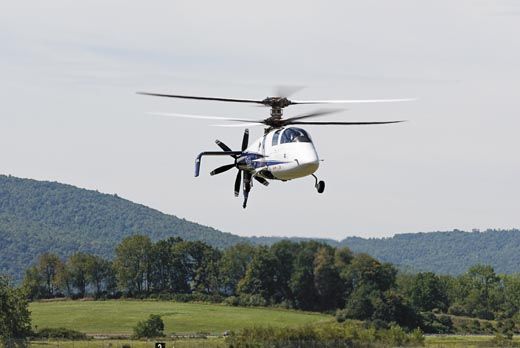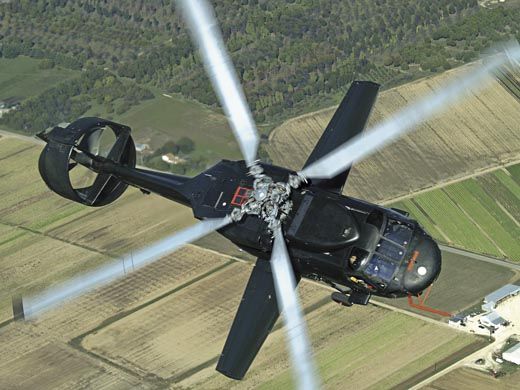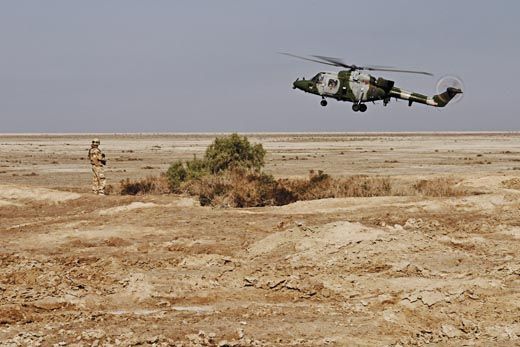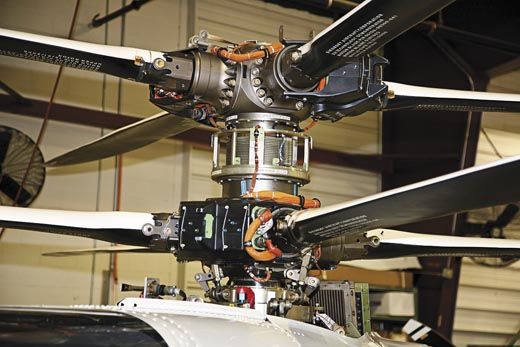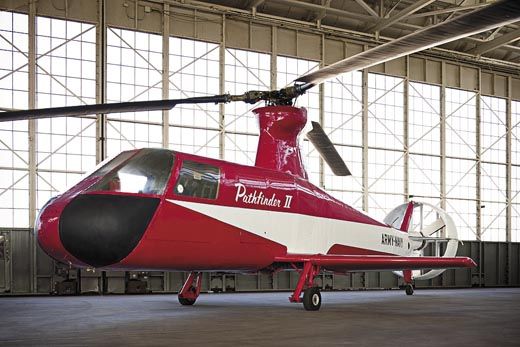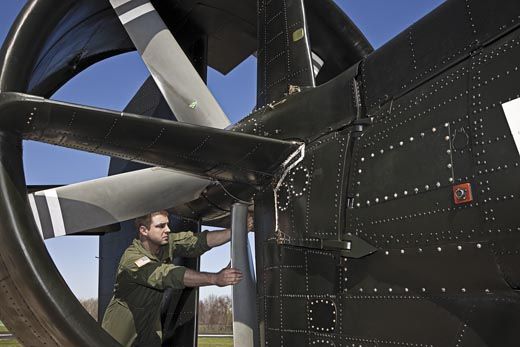Hot-Rod Helicopters
There’s just no way to add 100 mph to the speed of a helicopter. Or is there?
/https://tf-cmsv2-smithsonianmag-media.s3.amazonaws.com/filer/Today_Copter_Flash_SEP09.jpg)
When it comes to hoisting cargo on a sling, dueling with insurgents barricaded in an apartment building, touching down on mountaintops, or slipping between looming obstacles, nothing can match helicopters. But in the overall ranks of aircraft, they remain a niche player. Whether you measure in passenger miles, number of registered aircraft, or number of pilots, airplanes have helicopters beat.
One reason is that helicopters have a woefully low speed limit. Today, we might call it Nelson’s Speed Limit. In May 1861, Mortimer Nelson, a Manhattan greeting-card printer, won the first U.S. patent for what we would now call a helicopter. About 33 feet long and weighing half a ton, Nelson’s Aerial Car—to be powered by supercharged whale oil—would have two sets of rotors: a big pair for lift and a little pair, flanking the rudder in the back, that acted as propellers. Nelson predicted that the latter set would drive the Aerial Car at speeds of up to 180 mph. His design never flew, but his prediction about the limits of helicopter velocity has proved remarkably accurate: Today, most production helicopters’ top practical speeds are under 180 mph.
For the Sikorsky Black Hawk, the limit at cruise speed is about 140 mph, and, if pushed to “dash speed,” a little over 200 mph, sustainable for only 10 minutes at a time, since longer periods exert too much wear on the mechanical systems, such as the gear box. For a Bell AH-1W Cobra without external ordnance, absolute top speed is 220 mph, according to Marine Lieutenant Colonel Wade Hasle, who spent two tours flying Cobras over Iraq. He himself never reached such a speed; “You only get going that fast in a dive,” he says. The official world helicopter speed record isn’t that much higher: In 1986, a Westland Lynx reached 249 mph.
Today, though, three companies—Piasecki Aircraft, Sikorsky Aircraft, and Boeing—are actively working on designs they hope will make Nelson’s speed limit as quaint a piece of helicopter history as whale-oil fuel.
Most of the Sluggishness of standard helicopters can be blamed on the rotor disk. Unlike an airplane’s propeller, a helicopter’s rotor disk has to move through the air sideways. On one side of the disk, the blades are rushing into the wind, and they experience a relative wind that is near (and sometimes above) the speed of sound. Slicing through wind that fast takes a lot of energy and is hard on the equipment. But just a few dozen feet away, on the other side of the disk, blades are rushing away from the direction of travel. If cruise speed goes too high, the retreating blades stall. Consequently, the aircraft is shaken by strong vibrations, and the nose is forced upward. At speeds beyond 100 mph or so, the drawbacks of the disk loom larger and larger until a point at which no extra engine power can shove the machine along any faster. (This became obvious when, beginning in the late 1950s, lightweight, high-power engines enabled helicopters to lift more weight, but didn’t fix the speed problem.)
For military helicopters, the speed limit represents a vulnerability that the enemy can take advantage of. For instance, if air support needs 15 minutes to reach a hot spot, the enemy can plan to stage an attack and then retreat before the defending helicopters ever show up.
Furthermore, says Colonel Greg Lengyel, who flew the Sikorsky MH-53J/M Pave Low for the Air Force and now commands the Florida-based First Special Operations Wing, a lot of military missions take place under cover of darkness. If helicopters are too slow, Lengyel explains, the plan must include finding a spot for the aircraft and crews to hide during daylight. “Any gain in helicopter speed would be helpful,” he says. “But if we’re talking about doubling it to 230 or 250 knots [about 265 to 290 mph], that’s what opens up the field.”
Over the years, every attempt to field a radically faster helicopter has resulted in some inadequacy (see sidebar, left). Added speed has meant poor payload capacity, instability, maintenance difficulties, high fuel consumption—or all of the above. Only three production vertical-takeoff-and-landing (VTOL) craft have reached high operational speeds, and all avoided the conventional-helicopter route entirely: one tiltrotor, the Bell-Boeing V-22 Osprey; and two designs that use engine exhaust for takeoff thrust: the McDonnell Douglas AV-8 Harrier and Yakovlev Yak-38 Forger. And the Forger is no longer in production.
One solution has been tried repeatedly: the compound helicopter. Compounds have hardware—fixed wings, propellers or jet engines—that enables them to take off like helicopters and then cruise as airplanes, flying at higher speeds. Creating a compound can be as straightforward as attaching wings and a propeller on a standard helicopter, or it can mean designing and making one from scratch in hopes of keeping tradeoffs, such as additional weight and mechanical complexity, to an absolute minimum.
Piasecki Aircraft has developed a kit for compounding existing military helicopters with a Vectored Thrust Ducted Propeller—an eight-foot-diameter, tailboom-mounted, shrouded propeller, nicknamed “the ringtail.” The company hopes that the kit, along with a fixed wing from a business jet, will transform thousands of Sikorsky H-60 Black Hawk helicopters into SpeedHawks, bringing them into the fast lane, on a short schedule and a low budget.
On October 16, 2008, the company publicly debuted its single SpeedHawk, the X-49A demonstrator. The presentation took place at the New Castle County Airport, near Wilmington, Delaware.
The day was a mixture of celebration (this would be the last of the Phase I flights the Army contract required) and trepidation (Would the military cough up money for the next phase of tests?). Guests gathered to drink coffee and amble through exhibits and posters reprising Piasecki’s decades of research. Most pertinent was a SpeedHawk forerunner called the Pathfinder II, a turbine-powered compound helicopter with a ring-encased tail thruster, which in 1964 reached 225 mph. (It never went into production.) Later, Piasecki designed ducted-propeller upgrades for the Cobra and the Hughes AH-64 Apache; a mockup of the compounded Cobra and a poster of the modified Apache were on display.
Piasecki has a long history of developing vertical-flight variants. Though the company has manufactured no aircraft since 1955, it has developed and flown dozens of prototypes. Visitors at the airport got a look at the Air Geep, a two-turbine runabout designed for the Army and a magazine cover star of its day, and an unmanned Geep variant called the Air Scout. In the back lot of the company’s Essington, Pennsylvania headquarters, visitors can see remnants from the Heli-Stat, a heavy-lifting experiment in which a metal framework attached four H-34 helicopters to a blimp. (A crash ended the project.)
John Piasecki, son of company founder Frank and now president, took the podium to thank the assembled uniforms, a Congressional delegation, representatives from other corporations, and Piasecki workers. Guests then filed out to check out the world’s only SpeedHawk. The aircraft, painted black, bore the red Piasecki logo, a two-legged triangle with a superimposed oval that presaged the insignia of the Star Trek crew.
Once the guests had assembled, the SpeedHawk embarked on a routine demonstrating high-G turns, quick takeoffs, and short stops. At this phase of research, a Navy rule limits speeds, so the flyby was capped at about 200 mph. (The company says the X-49A has reached 203 mph “in a slight descent,” and expects SpeedHawks to ultimately attain a maximum speed of 230 mph.)
The most striking feature was not the set of stubby wings (taken from an Aerostar FJ-100 business jet) but the Vectored Thrust Ducted Propeller. Tucked into the shroud are clamshell-like diverters that emerge in sections, projecting out of the shroud and forming a right-angle duct for sending the propeller’s thrust off to the side. During takeoff and slow-speed flight, the arrangement fills in for the typical tail rotor, which standard helicopters need to counteract the torque that the main rotor produces.
As the SpeedHawk accelerates to the point where less sideward thrust is needed, the duct retracts into the shroud. From then on, all directional control is exerted by a small rudder mounted inside the shroud. The main job of the propeller becomes providing forward thrust. (Attention, hotshot pilots: The ringtail’s push can also hold the helicopter at a steep nose-high attitude while hovering, a stunt that could be useful for a gunship tucked among the trees and waiting to bag an adversary. If an ordinary helicopter tried this, it would slide backward.)
The demonstration ended when the aircraft touched down tail-first, rolled up to face the crowd, and shut down for inspection.
Later, I spoke with Joe Cosgrove, director of program requirements, about some of the work that had preceded the demonstration. A helicopter is a delicately balanced machine with a minimum of extra hardware, so changing one thing usually triggers a long list of modifications and adjustments. Since the SpeedHawk goes unusually fast for a helicopter, explained Cosgrove, engineers decided to add a fairing around the rotor mast to cut aerodynamic drag. Another challenge was finding a place that was strong enough for the wing to attach to, and was very near the craft’s center of gravity. One possibility was immediately under the main rotor, but engineers chose an easier modification: the stout framing of the cabin floor. The final version, though, will have its wing mounted high, Cosgrove said, “and that will avoid troops climbing on it.”
The production version of the SpeedHawk will also stretch the cabin by almost four feet, replace the mechanical controls with digital ones, and replace the auxiliary power unit with a larger gas turbine, in order to deliver more horsepower to both the main rotor and the ringtail. The extra power should boost the speed and enable the craft to take off with more fuel, which increases range.
That’s if enough military money is rounded up to push the SpeedHawk upgrade kit through approval for manufacture and installation. The length of the procurement trail is a source of annoyance to John Piasecki. The standard procedure is broken, he says: “The procurement system is set up to motivate government program managers to eliminate competitive solutions, rather than create competition. Their job is to protect their program. But the responsibility of government is to leverage the innovative abilities of industry to get the best product for the expenditure of taxpayer dollars.” The military, he says, needs to look for solutions suited to the existing fleet, like the VTDP package. If it’s funded, the company hopes to have it ready for delivery in five or six years.
By contrast, the company’s closest competitor in the high-speed helicopter category, Sikorsky Aircraft’s X2, is an all-new design; Piasecki says that it will require many more years of work and hundreds of millions of dollars. “We’ve flown [the VTDP kit] full scale on an operational aircraft, the H-60, with a maximum weight of 24,000 pounds,” he says, whereas the X2, still in prototype, weighs only a quarter of that. “There’s no question that they [Sikorsky] could build a full-scale operational configuration, if sponsored by government. But they’d still face the timeline of a new-start aircraft.”
Several new-start military helicopter projects, despite having the great confidence of contractors and government backers, never made it through the whole developmental cycle: the AH-56A Cheyenne, a high-speed, heavily armed compound helicopter the Army commissioned during the Vietnam War; the Boeing/Sikorsky RAH-66 Comanche; and the Advanced Reconnaissance Helicopter.
By day, Sikorsky’s tom lawrence draws on 31 years of experience to advise on helicopter flight control systems, but by night, he is treasurer of the Sikorsky Historical Archives and a historian of vertical flight. On a recent trip I made to Sikorsky headquarters in Stratford, Connecticut, Lawrence invited me into his brown-walled cubicle, where he gave me a brief history of attempts to break through the limits of conventional VTOL flight.
Lawrence clicked through a slideshow of some of history’s more freakish vertical-flight variants: tilting jets, tilt-wings, ducted fans, tail-sitting airplanes, aircraft with rotors you could pack up and fold away. The Ling-Temco-Vought XC-142 tilt-wing created a downblast so strong it could throw rocks, knock people down, and uproot trees. Some models earned a few minutes of commentary, but others Lawrence dispatched with a single withering sentence: Of the Dassault Mirage III-V, which needed the thrust of eight jet engines to heave itself off the ground, he said: “Stand too close to this one and you’re French-fried.”
Sikorsky’s present innovation, the X2, is a helicopter with an aft propeller and what looks like an upside-down airplane tail. The X2 is Sikorsky’s second attempt to make a speed record breaker out of a coaxial helicopter (a coaxial has two main rotors mounted on one mast and turning in opposite directions; the arrangement maintains lift as speed increases). Sikorsky’s first attempt, the XH-59A prototype, flew for about 10 years beginning in 1973, but at high speeds it suffered from excessive vibration.
The X2 has an entirely new airframe, with new fly-by-wire controls, so several challenges have presented themselves so far. In the early stages, flight simulation software could speed development, but it could not predict every detail of the turbulence that might result as the two main rotors worked together. Following the first flight, in August 2008, test pilot Kevin Bredenbeck suggested some fine-tuning. Says advanced programs manager Jim Kagdis: “It was hot”—too sensitive to the pilot’s control inputs. “We adjusted the controls.”
Even if the X2 proves out, the drag its rotors create as they turn will probably hold speeds down to 300 mph. The limitation posed by rotors is the reason the Defense Advanced Research Projects Agency is paying Boeing and partner Virginia Tech University to develop the DiscRotor, a helicopter in which the main rotor can be packed away during flight into a circular housing, reminiscent of the radome atop an AWACS aircraft. In this phase of flight, fixed wings would provide the lift, perhaps assisted modestly by the smartly shaped rotor housing.
Such a craft has never taken to the air, so DARPA, says program manager Phil Hunt, is taking one careful step at a time. The project is presently in the conceptual stage, having completed a Phase 0 contract and entered Phase I.
In another edgy rotorcraft program—the X-50A Dragonfly, which would stop its rotors in flight and employ them as fixed wings—both unmanned prototypes crashed during test flights. So for this phase of the DiscRotor’s development, DARPA has pegged modest goals, asking only that wind tunnel tests through 2011 establish whether the design deserves more development money. In
theory, the helicopter could hit 400 mph, making it highly attractive for search-and-rescue in combat settings.
Exciting stuff, but the last word belongs to those who have to fly the things. Greg Lengyel, based at Florida’s Hurlburt Field, says faster machines need to come in large versions, capable of missions such as transport, external lift, and long-distance rescue: “If you have to trade lift for speed—if you can only go fast with helicopters the size of the Cobra or Apache [gunships]—you don’t gain very much.”
I asked Wade Hasle about tradeoffs that pilots would watch for, should faster helicopters hit the airways. “I don’t think it would be well received if a faster helicopter had limited vertical performance,” he says. In combat, good hover performance is a must, since a helicopter in the field often lacks the opportunity to gather speed with a rolling takeoff. No matter how fast it goes, in other words, the next-generation helicopters will still have to have the talents of the old-school ones.
James R. Chiles is the author of The God Machine: From Boomerangs to Black Hawks, the Story of the Helicopter (Bantam Dell, 2007).
